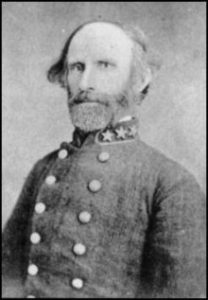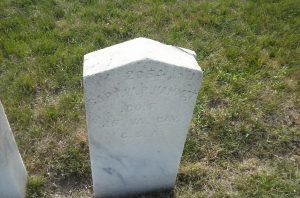A Tale of Three Hammets
 On May 14, 1864, just north of the Green family cabin, twenty-four-year-old Robert C. Hammet fell dead with a bullet in his brain. His regiment, the 54th Virginia, was ordered into a reckless, suicidal charge against a line of Federal infantry by their brigade commander, Alexander W. Reynolds, reputed to be drunk at the time. The Virginians closed to within a murderous five paces of the enemy line. Hammet “with pistol in hand, rushed forward, and seizing the Yankee colors, fired into their ranks, when a bullet pierced his brain and he fell dead upon the enemy’s works.” (Syracuse Daily Courier, June 13, 1864, reprinted from the Atlanta Intelligencer.)
On May 14, 1864, just north of the Green family cabin, twenty-four-year-old Robert C. Hammet fell dead with a bullet in his brain. His regiment, the 54th Virginia, was ordered into a reckless, suicidal charge against a line of Federal infantry by their brigade commander, Alexander W. Reynolds, reputed to be drunk at the time. The Virginians closed to within a murderous five paces of the enemy line. Hammet “with pistol in hand, rushed forward, and seizing the Yankee colors, fired into their ranks, when a bullet pierced his brain and he fell dead upon the enemy’s works.” (Syracuse Daily Courier, June 13, 1864, reprinted from the Atlanta Intelligencer.)

Captain Robert Hammet, formerly the regimental adjutant, commanded Company A of the 54th Virginia in that charge. A native of Montgomery County, Hammet joined the 54th in the spring of 1862 when he was appointed adjutant. His younger brother John was already serving in the same regiment, rising to command Company I in July, 1862. Led by Col. Robert C. Trigg, the 54th served in southwest Virginia early in the war, before joining Braxton Bragg’s Army of Tennessee in time for the Battle of Chickamauga. A third brother, William, served with the 25th Virginia Cavalry.
The Hammets came to the United States in the early 1800s. Edward Hammet, born in 1802, emigrated from Ireland. He was following a cousin, also named John, who arrived a few years earlier. That John Hammet became an overseer to a man named John Preston. Edward took up farming, married and settled in Montgomery County, where he clearly prospered. The eldest son, James, attended the new Virginia Military Institute (opened in 1839) up in Lexington, a member of the class of 1853. He then studied medicine, married in 1855, and was a practicing physician in Montgomery County. In 1861 he was an officer in the 24th Virginia Infantry, but soon returned to practicing medicine as a Confederate Surgeon. Robert attended Emery and Henry College, graduating in 1857 at the age of 20. John also attended V.M.I., as shown on the 1860 census, where his profession was listed as “cadet.” He was a member of the class of 1862, though he and his classmates were graduated in 1861 due to the national crisis. The youngest, William was also enrolled at VMI, class of 1864; though the war cut short his classroom education. William resigned from the institute in 1862 to join the army. Two younger sisters, Isabella and Susan, remained at home.
The Hammet Family suffered their first wartime loss when John R. Hammet was wounded at Chickamauga on September 19, during the fighting in Viniard Field. That injury proved mortal. John reportedly died that November, at home, while on medical leave. Then came Robert’s death at Resaca, 6 months later. William’s loss was especially tragic: captured in Southwest Virginia on April 6, 1865, he was transported first to Nashville, and then sent to Camp Chase Prison Camp in Columbus Ohio. He perished from pneumonia on June 30, 1865, after the war’s effective end. William must have been an ardent secessionist even at that late date, for it should have been possible for him to secure a release from captivity simply by taking the Oath of Loyalty to the United States; by that late in the conflict thousands of ex-Confederates had gained their liberty by so swearing. The record is silent on why William was either not offered the oath or declined it. If he refused, he paid a stiff price for that refusal.

Thus, by the end of the war, three of Edward and Clementine Hammet’s four sons were dead, sacrificed for the dream of an independent Confederacy.
But the story doesn’t end there.
The remainder of John’s service record, as found in the archives and now on the Fold3 military records website, contains compelling evidence that John Hammet did not die of wounds in November, 1863; far from it. Vouchers show that he was drawing his monthly pay ($130 per month) up through at least February of 1865. Moreover, a closer look at the card reporting Hammet’s death reveals a curious anomaly: it shows the death of PRIVATE John R. Hammett – a different rank and slightly different spelling of the last name. Variant spellings are to be expected, and no real surprise, but the difference in rank is confusing. Other searches don’t reveal any additional John Hammet(t)s in the 54th, but this information, coupled with all of those signed pay vouchers strongly suggests that Captain John Hammet survived his wound. In fact, he did survive. The 1870 census has him living with is father and mother, at their home —“Lovely Mount”—his profession listed as farmer. He died on March 26, 1876, aged 38 or 39. There is no record of any marriage.
Then we come to Robert. Despite what seemed an obvious, well-documented death, in November of 1864 word reached Edward that an “adjutant Hammett” of the 54th Virginia was still alive in a federal hospital “either at Knoxville or Chattanooga.” Through James, Edward began making inquiries, initially through Confederate Maj. Gen. John C. Breckinridge, asking that officer to contact his Union counterparts. The Hammets provided a description of Robert in case he was insensible or otherwise unable to provide his name. The Confederates obliged, but the answers that came back were disheartening. No patient by that name was enrolled in any hospital, nor did any patient fit the description provided. If Robert lived, it was not for long, and he was probably buried in an unmarked grave. William’s demise and resting place, of course, are well documented, placing him at Camp Chase, in Ohio.
Edward Hammet died in about 1870. His wife Clementine passed in 1878, two years after John. James died the next year, 1879. The two daughters survived into the 20th Century. Isabella married a man named Heth, and lived until 1912. Susan married James Hoge Tyler, the Governor of Virginia from 1898 to 1902. Susan lived until 1927.
I view the story of the Hammets as a cautionary tale. Researching the war and the people who fought it is rarely as clear-cut as it seems, and there are always loose ends. What was Robert’s ultimate fate? Why was William not paroled? I find the consistent confusion over John’s date of death especially interesting, especially since he was never among the missing; with the exception of the misfiled death card, his records are clear and unambiguous. To me, John’s story reinforces the old adage: take nothing for granted.
Excellent sleuthing and historiography.
My ancestor’s Cw record is also somewhat obscure. We’re not sure of his exact status after the Summer of 1863. One of my retirement “to dos”.?
The Compiled Military Service Records (CMSR) can get confused at times. One of my ancestors served in the 12th Virginia Cavalry and was captured or surrendered or deserted (he is shown under all 3 statuses) at the Brandy Station in 1863. The enrollment registers at the Wheeling,WV Athenaeum, Camp Chase, and Johnson Island show his regiment variously as the “12th Va Cav” or the “12th Va Regiment”, or just “12th Va”. However, the clerk(s) who were entering his information into the CMSR decided to put all these records in the files of the 12th Virginia Infantry.
I had always been told that he had been in the cavalry but this discrepancy in the CMSR threw me off for quite while – was he in the cavalry or was it actually the infantry? Ultimately, I found his record in the 1890 Veterans’ census. Although the census was meant only to enumerate Union veterans, the county in which he was living had counted all veterans, North and South; his regiment was identified as “12 Virg Cav”.